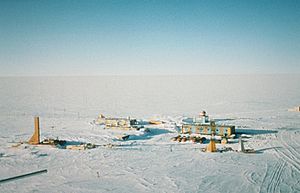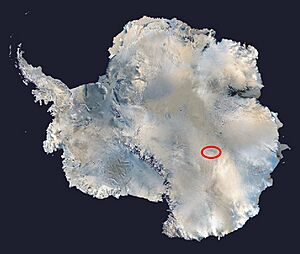Lowest temperature recorded on Earth facts for kids

Imagine a place so cold that your breath would instantly freeze! The lowest natural temperature ever directly measured on Earth was −89.2 °C (−128.6 °F). This incredible record happened at the Soviet Vostok Station in Antarctica on July 21, 1983. Scientists used special thermometers on the ground to get this reading.
Later, on August 10, 2010, satellites orbiting Earth found an even colder spot. They measured a surface temperature of −93.2 °C (−135.8 °F) in a high area between Dome Argus and Dome Fuji. This spot is about 3,900 m (12,800 ft) high. However, this temperature was measured from space using "remote sensing" (like a super-sensitive camera), not by a thermometer on the ground. Because of this, it's not officially listed as the record for a direct measurement. The satellite reading shows the temperature of the ice surface, while the Vostok reading was the air temperature just above the ice. So, they are a bit different. More recent studies show many places in high Antarctica where surface temperatures can drop to around −98 °C (−144 °F).
How We Found the Coldest Spots
For a long time, people have been trying to find the coldest places on Earth. Here's how the record for the lowest temperature has changed over time:
Early Cold Records
In 1838, a Russian merchant named Neverov recorded a temperature of −60 °C (−76 °F) in Yakutsk, Russia. This was one of the earliest very cold readings.
Later, in 1885, a temperature of −68 °C (−90 °F) was noted in Verkhoyansk, Russia. This town is famous for its extreme cold. In 1892, an even colder temperature of −69.8 °C (−93.6 °F) was reported there.
In 1933, Soviet scientists announced a reading of −67.7 °C (−89.9 °F) in Oymyakon, another very cold place in Russia. This measurement was considered the record low for many years.
Antarctica Takes the Lead
The frozen continent of Antarctica soon became the place where new cold records were set.
In 1957, at the Amundsen–Scott South Pole Station, temperatures dropped to −73.6 °C (−100.5 °F) in May and then −74.5 °C (−102.1 °F) in September.
The next world record was set at the Soviet Vostok Station in 1968. It reached an amazing −88.3 °C (−126.9 °F) on the high Antarctic Plateau.
Vostok Station broke its own record again on July 21, 1983, with a temperature of −89.2 °C (−128.6 °F). This is still the official record for a temperature measured directly on the ground.
See also


